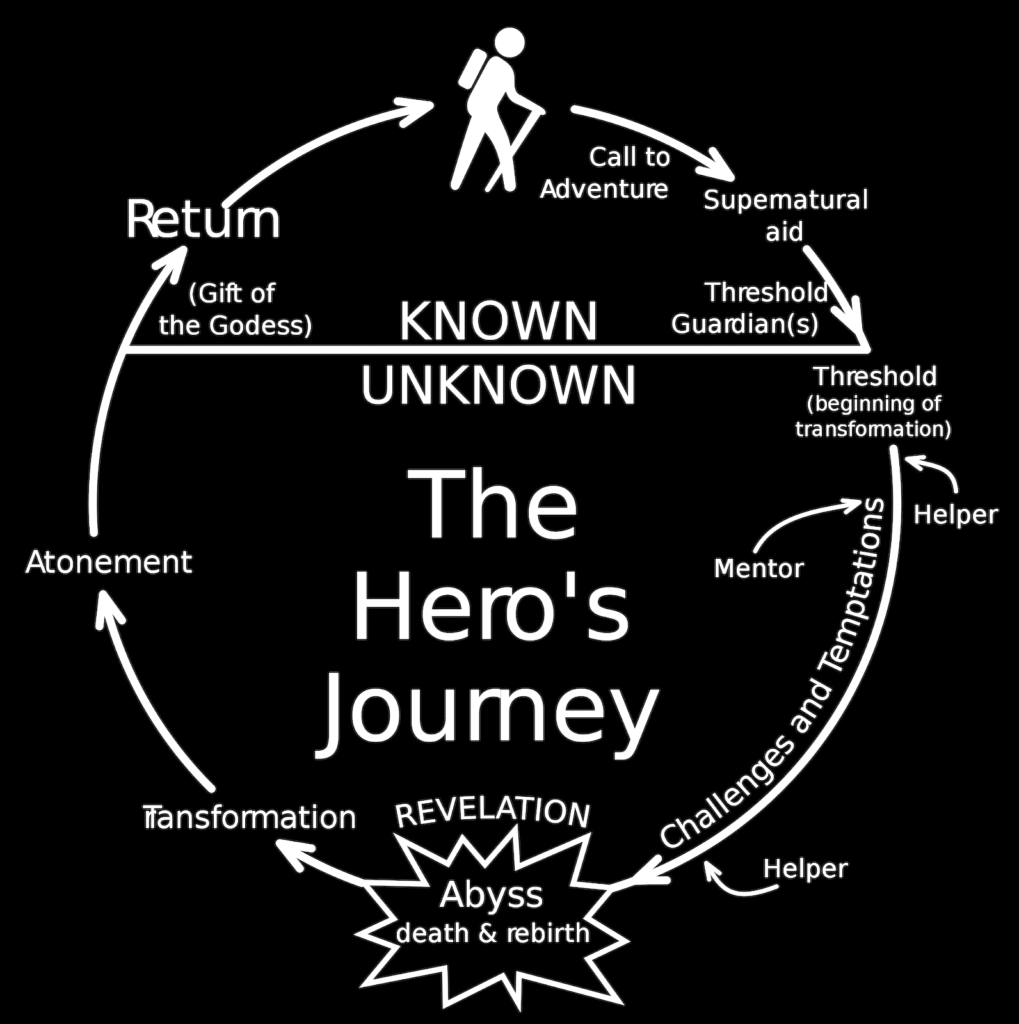Hero’s Journey: A Framework that Shapes the World’s Greatest Stories

If you’ve ever lost yourself in a good book, binge-watched an epic series, or sat on the edge of your seat in a darkened theater, chances are you’ve been under the spell of a story built on a structure thousands of years old.
This is the magic of Joseph Campbell’s Hero’s Journey—a storytelling blueprint that connects The Odyssey to Star Wars, Beowulf to Harry Potter, Gilgamesh to The Matrix. It’s a structure so deeply woven into our cultural DNA that even if you’ve never heard of it, you’ve felt it.
Campbell first laid it out in his landmark book The Hero with a Thousand Faces in 1949. After studying myths and legends from every corner of the world, he realized that humanity tells the same essential story over and over again: a hero leaves the safety of the familiar, faces trials, transforms through struggle, and returns home forever changed.
This isn’t just a framework for myths—it’s the arc of our own lives.
Why the Hero’s Journey Works (and Why It’s Everywhere)
Stories have been our most powerful way of making sense of the world long before the first words were ever written down. Around fires, in temples, through song and dance, humans have always told tales to explain the unknown, to teach lessons, to pass on wisdom, and—let’s be honest—to entertain.
The Hero’s Journey works because it reflects something far deeper than plot mechanics—it mirrors the human experience itself. At its core, this framework is a map of change, a mirror for the cycles we all live through:
- We start in the familiar.
- Something disrupts our comfort.
- We’re challenged, tested, sometimes broken.
- We learn, adapt, and grow.
- And if we’re lucky, we return to the world with something worth sharing.
This pattern resonates so powerfully because it’s our pattern. Whether you’re starting a business, raising a child, fighting an illness, or moving to a new city, you are stepping through these same emotional beats—fear, resistance, mentorship, risk, trial, triumph, and transformation.
A Universal Language
The beauty of the Hero’s Journey is that it transcends time, culture, and genre. It’s in the Iliad and The Odyssey. It’s in ancient Hindu epics like the Ramayana. It’s in African folk tales, Norse sagas, and Native American legends. And it’s also in superhero films, video games, animated Disney movies, and bestselling novels.
When we see Luke Skywalker debating whether to leave Tatooine, or Harry Potter standing at Platform 9¾, we feel a twinge of recognition—not because we’ve been to a galaxy far, far away or a magical school, but because we know what it’s like to face the threshold between the safe and the unknown.
Emotion Over Events
What’s important to understand is that the Hero’s Journey is not about what happens—it’s about how it feels.
- It’s not just a monster battle—it’s facing a fear you’ve avoided your whole life.
- It’s not just a mentor’s advice—it’s that moment when someone believes in you before you believe in yourself.
- It’s not just a return home—it’s coming back as someone your old world barely recognizes.
This emotional blueprint is why the framework is so adaptable. You can set it in outer space, medieval kingdoms, cyberpunk dystopias, or quiet suburban neighborhoods, and it still works.
Why It’s Everywhere
Once you recognize the Hero’s Journey, you’ll see it in everything:
- Blockbusters (Star Wars, The Matrix, Black Panther)
- Novels (The Lord of the Rings, The Alchemist, The Hunger Games)
- Children’s stories (The Lion King, Frozen, Moana)
- Even in marketing campaigns that guide you from “problem” (Ordinary World) to “solution” (Return with the Elixir).
The reason is simple—our brains are wired for stories, and this one structure has been stress-tested by thousands of years of human history. It has survived because it works.
The 12 Stages of the Hero’s Journey
The Hero’s Journey isn’t just a straight line—it’s a cycle, a map of transformation that repeats in myths, movies, novels, and even in our own lives. Each stage has a unique emotional flavor, and together they form a complete arc of departure, transformation, and return.

- Ordinary World
Every journey begins with a baseline—a glimpse of the hero’s normal life before the storm. This stage grounds us, lets us see what’s at stake, and gives us a “before” picture we can measure against the “after.”
Example: Luke Skywalker fixing droids on a dusty farm, unaware of the galaxy-changing destiny ahead. - Call to Adventure
Something disrupts the comfort zone—a challenge, an opportunity, or a crisis that demands action.
Example: Moana hears the ocean’s call, literally pulling her toward a journey that will save her people. - Refusal of the Call
The hero hesitates. Fear, self-doubt, or loyalty to the familiar holds them back.
Example: Frodo doesn’t immediately want to take the Ring to Mordor; it’s dangerous, and he feels unqualified. - Meeting the Mentor
Help arrives—a wise figure, a teacher, or an unlikely ally—someone who provides guidance, tools, or courage.
Example: In The Matrix, Morpheus offers Neo the red pill and a chance to see the truth. - Crossing the Threshold
This is the point of no return—the hero commits to the journey and steps into the “special world” of the adventure.
Example: Harry Potter boarding the Hogwarts Express, leaving the ordinary world of Privet Drive behind. - Tests, Allies, and Enemies
The hero learns the ropes of the new world, meets friends, and encounters foes.
Example: Katniss Everdeen navigates alliances and rivalries in The Hunger Games arena. - Approach to the Inmost Cave
The hero prepares for a major confrontation—physically, emotionally, or both.
Example: The Fellowship’s tense journey through the Mines of Moria before facing the Balrog. - Ordeal
The central crisis—the hero faces their biggest fear, risking everything.
Example: Simba confronting Scar in The Lion King, reclaiming his place in the Circle of Life. - Reward (Seizing the Sword)
The hero survives the ordeal and gains something of value—treasure, knowledge, or self-realization.
Example: Indiana Jones escaping with the Ark—though often, the reward isn’t what the hero thought they needed. - The Road Back
The journey home begins, but it’s not smooth sailing.
Example: In The Lord of the Rings, the journey back from Mount Doom is just as treacherous as the journey there. - Resurrection
A final test—the hero faces death one more time, proving they’ve truly transformed.
Example: In The Matrix, Neo is killed by Agent Smith but rises again with complete mastery over the Matrix. - Return with the Elixir
The hero comes back to the ordinary world, bringing something of value that can benefit others.
Example: Moana returns with the restored heart of Te Fiti, saving her people and reviving their voyaging spirit.
How I Use the Hero’s Journey in My Writing
Over the years, I’ve learned that The Hero’s Journey is more than a storytelling tool—it’s a compass.
- In my fiction, it helps me shape a narrative so the reader feels the rise and fall of tension, the deep breath before the plunge, and the satisfaction of a meaningful resolution. Even in fantastical worlds with dragons, space pirates, or enchanted forests, this human rhythm keeps the story grounded.
- In my blogs, I often place you, the reader, in the role of the hero. The “Ordinary World” might be a common challenge you face. The “Call to Adventure” is an idea or insight I invite you to explore. The “Return with the Elixir” is the key takeaway or practical wisdom you leave with.
Sometimes, I even reverse-engineer a post: I start with the transformation I want my reader to experience, then work backward through the stages. It’s like designing a roller coaster—you build the track so the ride is unforgettable.
The Journey You’re Already On
The truth is, we’re all on some stage of our own Hero’s Journey right now. You might be in the comfortable Ordinary World, sensing that something needs to change. You might be deep in the Ordeal, where the way forward seems impossible. Or perhaps you’ve just returned with your “elixir” and are wondering what’s next.
The gift of Campbell’s framework is that it reminds us: the challenges aren’t the end—they’re the forge that shapes us.
So here’s my question to you:
If your life right now were a chapter in a hero’s tale, which part of the journey would you be in? And what will you bring back when your adventure is done?
Bibliography (Amazon links to purchase books):
- The Hero with a Thousand Faces (The Collected Works of Joseph Campbell) by Joseph Campbell
- The Hero’s Journey: Joseph Campbell on His Life and Work (The Collected Works of Joseph Campbell) by Joseph Campbell, Phil Cousineau, Stuart L. Brown
- The Power of Myth by Joseph Campbell, Bill Moyers
👁️ 186 views

